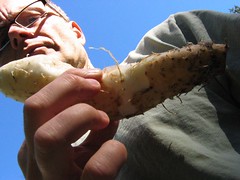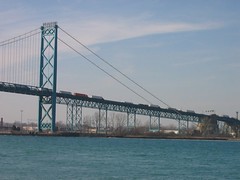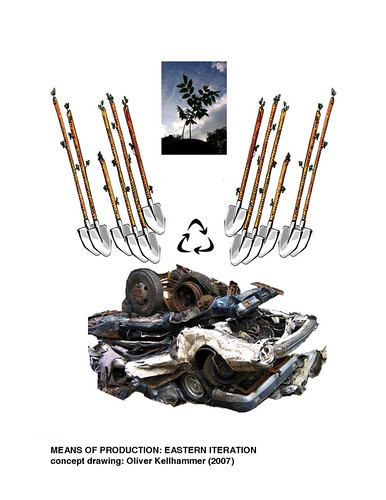
Japanese Mountain Yam

Ambassador Bridge, Windsor, Ontario.
Well OK. It’s been a long time in coming. And as usual life has been full of endless distractions, all of which have been convenient as excuses that have kept me from posting to THE SHOW SO FAR. Frankly, I had been thinking I would give the whole thing up. Then the e-mails started coming in. It seems that some people actually *read* this thing and want me to continue. Yet still I resisted. What ultimately brought me back here was the discovery of this winsome little tuber. The Japanese mountain yam had been a kind of holy grail for me, resisting all of my previous attempts at its cultivation, here on this damp, cold little Canadian island. But I just hadn’t been patient enough. I planted this one from a little sliver over three years ago and then completely forgot about it. One day in early October, I was weeding my cold frame–And there it was! Perfect. Wonderful. It had been growing underground all this time. The mountain yam or yama-imo is unusual among yams because it is traditionally eaten raw. We ate ours sliced with a little plum paste and shoyu. It tastes deliciously cool and a little slimy. If you click the above link you will no doubt be *amused* by its surprising non-food uses!
There have been so many things I wanted to share with you, dear readers from my various forays this year such as: the ethereal photographs of Taryn Simon’s American Index, the enigmatic, cut apart reverse architecture of Gordon Matta-Clark, and Tacita Dean’s haunting film about a film factory about to close forever. These things and many more besides have burned themselves into my visual cortex and are now resurfacing, as the cold winter rain starts to pelt my tin roof, here on this remote island outpost.

I have been on the road a lot, giving lectures at colleges on my ‘botanical interventions’ projects, starting with a gig at the Artists Urban Plans conference in Windsor Ontario, followed by NYU, Smith College and UBC’s Interdisciplinary Studies department. And it’s not over yet. Engagements in Japan and Florida are coming up in the New Year. It feels a little odd that there is such a sudden flurry of interest in my work, because, after all, I’ve been doing these things since the mid 1980’s. Still it’s great to be out there meeting other practitioners. The Green Corridor project, which co-hosted the Windsor conference is a particularly remarkable initiative. Organized by Ontario artists Noel Harding and Rod Strickland, Green Corridor is a large scale, multi-disciplinary attempt to integrate artists, planners, and technical people into the greening of the main thoroughfare that connects Windsor to adjoining Detroit, Michigan: the busiest border crossing in Canada.
As part of that project, I have proposed a plantation of hickory trees to be installed near the Ambassador Bridge; the conduit that funnels the immense traffic flow in and out of America, and all the attendant noise and pollution problems that go with it. The trees, which are native to the area, will help purify the air, act as a carbon sink and furnish the occasional crop of tool handles, which will be harvested using the ecologically sustainable technique of coppicing. The handles will be used for garden tools like shovels and picks, the business ends of which will be forged from scrap automobile parts using guerrilla blacksmithing techniques.
In case you missed it, Rebecca Solnit wrote a beautiful piece called Detroit Arcadia: Exploring the post-American Landscape in the July 2007 Harper’s. In it she describes the devolution/evolution of the Motor City from model American metropolis (and the the birthplace of Fordism) into its present state, where large parts of the former industrial heartland have become a post industrial, ruin ecology. Stephen Vogel, Dean of Architecture at University of Detroit Mercy painted a similar picture in his amazing presentation at the Windsor conference. He described Detroit neighbourhoods where the street lights don’t work anymore and 911 service is no longer available. Large areas of the downtown are reverting to savannah-like ruderal ecologies, inhabited by flocks of urban pheasants. Paradoxically, these ghetto pheasants are now being trapped by the crashed recently, threatening the area’s lucrative hunting economy. Apparently the inner city pheasants are doing fine in their new rural environs, a good deal cannier no doubt then their country-born predecessors.
Oh, and I’ve still been living the ‘writing life,’ only my stuff is starting to get published on (can you believe it?)—paper! Check out my short story ‘Overpass’ in the new issue of the Vancouver Review and a non-fiction thing called ‘I Love Turtles’ in the latest Knock Magazine.


